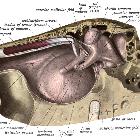Ossicular chain disruption






Ossicular chain disruption (or ossicular discontinuity) is loss of normal alignment between the three middle ear ossicles. The condition is a cause of conductive hearing loss.
Epidemiology
Exact incidence and prevalence are not known. Hearing loss associated with temporal bone fractures in children occurs in 75%, but persists beyond 1 month in less than 15%.
Clinical presentation
Sudden conductive hearing loss in traumatic cases. The hearing loss may be due to ossicular chain disruption or middle ear hemorrhage. Sensorineural hearing loss may coexist, e.g. in temporal bone fractures that have a transverse component.
Ancillary features include hemotympanum and/or otorrhea.
Pathology
Etiology
- traumatic
- temporal bone fracture, especially longitudinal type
- blast injuries
- rare causes e.g. lightning strike
- atraumatic
- congenital
- erosive disease
- cholesteatoma
- chronic middle ear infection
Location
The following types of ossicular chain disruption are listed by frequency :
- most common
- incudomalleolar joint separation
- incudostapedial joint separation
- less common
- dislocation of the incus
- dislocation of the malleoincudal complex
- rare
- stapedovestibular dislocation
- ossicular fracture
Radiographic features
CT
- incudomalleolar joint separation
- axial images: the normal ice cream cone appearance is disrupted such that the ice cream scoop (head of malleus) appears falling off the cone (body and short process of incus)
- coronal images: broken heart sign
- incudostapedial joint separation
- long and lenticular process of incus are laterally displaced away from the head of the stapes
3D reconstructions are useful for surgical planning.
Treatment and prognosis
Conductive hearing loss of more than 30 dB persisting for six months post-injury is considered an indication for the reconstruction of the ossicular chain:
- conservative:
- hearing aids
- surgical (acute or delayed):
- relocation: reconstruction with a hydroxyapatite prosthesis and/or cartilage allograft
See also
Siehe auch:
und weiter:

 Assoziationen und Differentialdiagnosen zu Luxation Gehörknöchelchen:
Assoziationen und Differentialdiagnosen zu Luxation Gehörknöchelchen:
